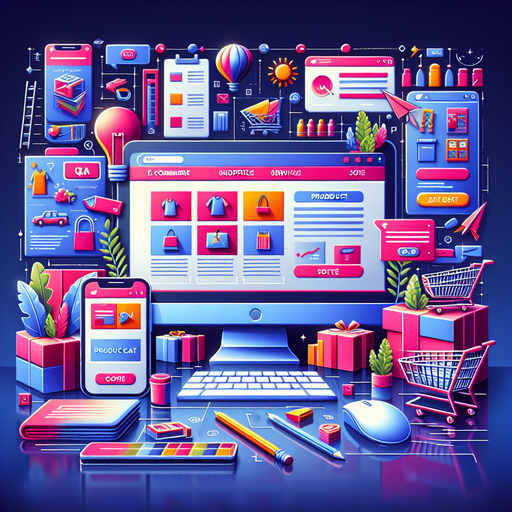
-
Table of Contents
Discover the latest trends and elevate your online store! Get inspired by cutting-edge web design for e-commerce sites. Explore Now!
Introduction
In the rapidly evolving digital marketplace, the design of an e-commerce website plays a pivotal role in attracting and retaining customers. Web design inspiration for e-commerce sites encompasses a blend of aesthetics, functionality, and user experience to create an engaging and seamless shopping journey. Effective e-commerce design not only highlights the products but also ensures intuitive navigation, fast loading times, and mobile responsiveness. By integrating innovative design elements, such as high-quality visuals, interactive features, and personalized user interfaces, businesses can enhance their online presence and drive conversions. Staying abreast of the latest design trends and best practices is essential for creating a compelling and competitive e-commerce platform that meets the dynamic needs of today’s consumers.
Top 10 Web Design Trends for E-commerce Sites: Elevate Your Online Store with Custom Web Design and Responsive Web Design Services
In the ever-evolving world of e-commerce, staying ahead of the curve is crucial for businesses aiming to capture and retain customer attention. As online shopping continues to grow, the importance of a well-designed website cannot be overstated. Custom web design and responsive web design services are essential tools for creating an engaging and user-friendly online store. To help you elevate your e-commerce site, here are the top 10 web design trends that are making waves in the industry.
First and foremost, minimalism remains a powerful trend in web design. By focusing on simplicity and clarity, minimalistic designs help to reduce clutter and enhance the user experience. This approach not only makes navigation easier but also ensures that the most important elements, such as product images and calls to action, stand out. Coupled with ample white space, minimalism can create a clean and sophisticated look that appeals to modern consumers.
Next, the use of bold typography is gaining traction as a way to make a statement and capture attention. Large, eye-catching fonts can effectively convey your brand’s personality and message. When combined with minimalistic design, bold typography can create a striking visual impact that draws users in and encourages them to explore further.
Another trend that is transforming e-commerce sites is the integration of high-quality visuals. From stunning product photography to immersive videos, visuals play a crucial role in showcasing products and telling your brand’s story. Investing in professional photography and videography can significantly enhance the overall aesthetic of your site and provide a more engaging shopping experience for your customers.
In addition to visuals, micro-interactions are becoming increasingly popular in web design. These small, subtle animations and effects can add a layer of interactivity to your site, making it more dynamic and engaging. Whether it’s a hover effect on a product image or a subtle animation when adding an item to the cart, micro-interactions can enhance the user experience and make your site feel more polished and professional.
Furthermore, personalized experiences are a key trend in e-commerce web design. By leveraging data and analytics, you can create tailored experiences for your customers, such as personalized product recommendations and targeted promotions. This level of customization can help to build stronger connections with your audience and increase customer loyalty.
Responsive web design is another critical trend that cannot be ignored. With the increasing use of mobile devices for online shopping, ensuring that your site is fully optimized for all screen sizes is essential. Responsive design ensures that your site looks and functions seamlessly across desktops, tablets, and smartphones, providing a consistent and enjoyable experience for all users.
Moreover, the use of chatbots and AI-driven customer support is on the rise. These tools can provide instant assistance to customers, answering questions and guiding them through the purchasing process. By offering real-time support, chatbots can help to improve customer satisfaction and reduce cart abandonment rates.
Additionally, the incorporation of social proof elements, such as customer reviews and testimonials, can significantly impact purchasing decisions. Showcasing positive feedback from satisfied customers can build trust and credibility, encouraging new visitors to make a purchase.
Lastly, the trend of sustainability and eco-friendly design is gaining momentum. Consumers are increasingly conscious of the environmental impact of their purchases, and incorporating sustainable practices into your web design can resonate with this growing demographic. Highlighting eco-friendly products and practices can help to attract and retain environmentally conscious customers.
In conclusion, staying current with web design trends is essential for creating a successful e-commerce site. By embracing minimalism, bold typography, high-quality visuals, micro-interactions, personalized experiences, responsive design, chatbots, social proof, and sustainability, you can elevate your online store and provide an exceptional shopping experience for your customers. Custom web design and responsive web design services are invaluable in achieving these goals and ensuring that your site stands out in a competitive market.
Q&A
1. **What are some key elements to consider for web design inspiration for e-commerce sites?**
– **User-Friendly Navigation:** Ensure easy access to product categories and search functionality.
– **Responsive Design:** Optimize for mobile and various devices.
– **High-Quality Images:** Use professional photos and videos to showcase products.
– **Clear Call-to-Actions (CTAs):** Make it easy for users to add items to the cart and proceed to checkout.
– **Fast Loading Times:** Optimize site speed to reduce bounce rates.
– **Trust Signals:** Include customer reviews, security badges, and clear return policies.
– **Personalization:** Offer personalized recommendations based on user behavior.
– **Minimalist Design:** Keep the design clean and focused on products.
– **Consistent Branding:** Use consistent colors, fonts, and imagery that reflect your brand.
– **Accessibility:** Ensure the site is accessible to all users, including those with disabilities.